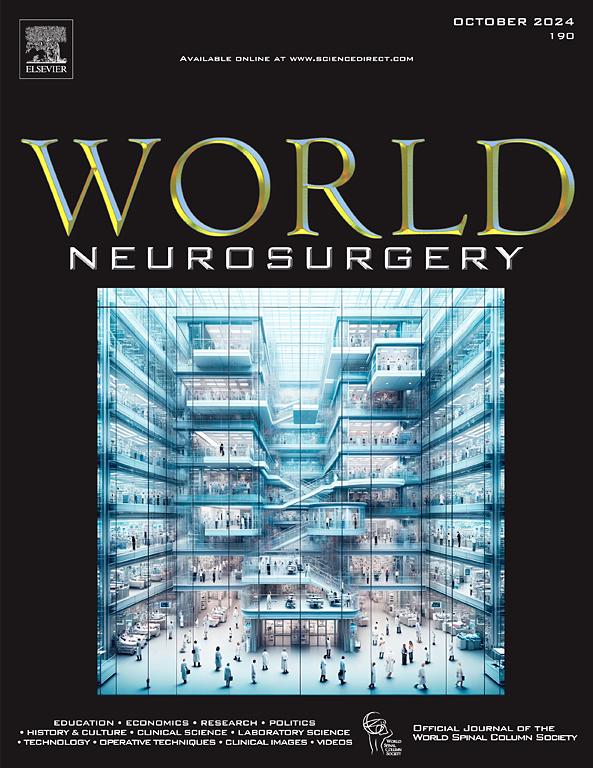Kinematic Analysis of the Hindbrain via Dynamic Neck Motion in Adult Patients with Chiari Malformation Type I: A Radiological Study with Clinical Implications
IF 1.9
4区 医学
Q3 CLINICAL NEUROLOGY
引用次数: 0
Abstract
Background
The influence of cervical motion on the hindbrain in patients with Chiari malformation type I (CMI) remains under investigation. In this study, the kinematic effects of cervical extension and flexion on cerebellar tonsillar herniation were evaluated.
Methods
The clinical data of 27 adult CMI patients were retrospectively studied, and sex- and age-matched patients with cervical spondylopathy were included as controls. Several linear, angular variables related to the hindbrain and mobility of the neck were assessed on midsagittal views of neutral and dynamic cervical magnetic resonance images.
Results
The distance of cerebellar tonsillar herniation (D-Ton) in the CMI group was 10.15 ± 0.74 mm in the cervical neutral position, 11.24 ± 0.81 mm (P <0.001) in flexion, and 9.12 ± 0.65 mm (P <0.001) in extension. D-Ton in the control group remained unchanged in three different cervical positions. No significant differences were found in the tissue strain of the tonsils (Ton-Strain), the distance from the obex (D-Obex), the anterior margin of the pontomedullary (D-Pon), or the cervicomedullary (D-Medu) junction to the McRae line between different cervical positions in either group.
Conclusions
The mobility of the ectopic tonsils and the degree of cervical motion were verified in adult CMI patients. The herniated tonsils largely ascended with extension and descended with flexion, without obvious tonsillar tissue strain, whereas the brain stem remained stable. Tonsillar motion may be a potential marker of CMI and may therefore help surgeons confirm CMI as well as tailor surgical procedures for such patients.
通过动态颈部运动对成年I型Chiari畸形患者后脑的运动学分析:一项具有临床意义的影像学研究。
背景:颈椎运动对I型Chiari畸形(CMI)患者后脑的影响仍在研究中。在这项研究中,颈椎伸展和屈曲对小脑扁桃体疝的运动学影响进行了评估。方法:回顾性分析27例成人CMI患者的临床资料,并以性别、年龄相匹配的颈椎病患者为对照。在中性和动态颈椎MR图像的正中矢状面上评估与后脑和颈部活动有关的几个线性、角度变量。结果:CMI组小脑扁桃体疝(D-Ton)距离为10.15±0.74 mm(颈中性位),11.24±0.81 mm (p)。结论:成人CMI患者异位扁桃体的活动性和颈椎运动程度得到验证。突出的扁桃体大部分呈伸升屈降,扁桃体组织无明显张力,脑干保持稳定。扁桃体运动可能是CMI的潜在标志,因此可以帮助外科医生确认CMI,并为此类患者量身定制手术程序。
本文章由计算机程序翻译,如有差异,请以英文原文为准。
求助全文
约1分钟内获得全文
求助全文
来源期刊

World neurosurgery
CLINICAL NEUROLOGY-SURGERY
CiteScore
3.90
自引率
15.00%
发文量
1765
审稿时长
47 days
期刊介绍:
World Neurosurgery has an open access mirror journal World Neurosurgery: X, sharing the same aims and scope, editorial team, submission system and rigorous peer review.
The journal''s mission is to:
-To provide a first-class international forum and a 2-way conduit for dialogue that is relevant to neurosurgeons and providers who care for neurosurgery patients. The categories of the exchanged information include clinical and basic science, as well as global information that provide social, political, educational, economic, cultural or societal insights and knowledge that are of significance and relevance to worldwide neurosurgery patient care.
-To act as a primary intellectual catalyst for the stimulation of creativity, the creation of new knowledge, and the enhancement of quality neurosurgical care worldwide.
-To provide a forum for communication that enriches the lives of all neurosurgeons and their colleagues; and, in so doing, enriches the lives of their patients.
Topics to be addressed in World Neurosurgery include: EDUCATION, ECONOMICS, RESEARCH, POLITICS, HISTORY, CULTURE, CLINICAL SCIENCE, LABORATORY SCIENCE, TECHNOLOGY, OPERATIVE TECHNIQUES, CLINICAL IMAGES, VIDEOS
 求助内容:
求助内容: 应助结果提醒方式:
应助结果提醒方式:


